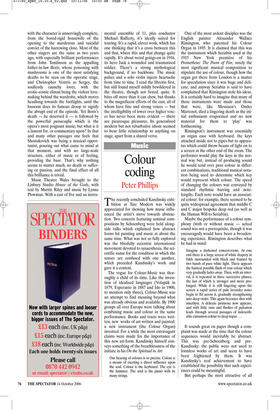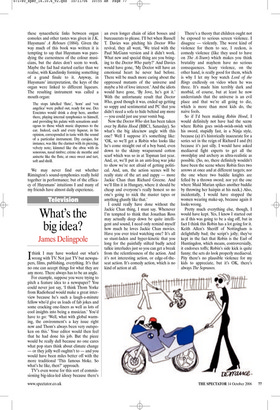Colour coding
Peter Phillips
The recently concluded Kandinsky exhibition at Tate Modern was widely appreciated for showing how music influenced the artist’s move towards abstraction. Two concerts featuring seminal compositions by Schoenberg were held alongside talks which explained how abstract forms hit painting and music at about the same time. What was not so fully explored was the blissfully eccentric international movement devoted to synaesthesia, the scientific name for the condition in which the senses are confused with one another, which preceded Kandinsky’s work and gave it a context.
The vogue for Colour-Music was thoroughly a child of its time. Like the invention of idealised languages (Volapük in 1879, Esperanto in 1887 and Ido in 1900, to mention only three), Colour-Music was an attempt to find meaning beyond what was already obvious and available. By 1900 groups all over Europe were talking about combining music and colour in the same performance. Books and tracts were written; new works of art written and painted; a new instrument (the Colour Organ) invented. For a while the most extravagant claims were made for the importance of this new art-form. Kandinsky himself conveys something of the breathlessness of the initiate in his On the Spiritual in Art:
Our hearing of colours is so precise. Colour is a means of exerting a direct influence upon the soul. Colour is the keyboard. The eye is the hammer. The soul is the piano with its many strings.
One of the most ardent disciples was the English painter Alexander Wallace Rimington, who patented his Colour Organ in 1895. It is claimed that this was the instrument which Scriabin used at the 1915 New York première of his Prometheus: The Poem of Fire, surely the most significant musical composition to stipulate the use of colour, though how the organ got there from London is a matter for speculation since it was huge and delicate; and anyway Scriabin is said to have complained that Rimington stole his ideas. It is certainly hard to imagine that many of these instruments were made and those that were, like Messiaen’s Ondes Martenot, died a lingering death as the initial enthusiasm evaporated and no new material for them to ‘play’ was forthcoming.
Rimington’s instrument was essentially an organ case with keyboard, the keys attached inside not to pipes but to apparatus which could throw beams of light on to a screen at the other end of the room. The performer would play the keys in the normal way but, instead of producing sound he would send over pure colour in different combinations, traditional musical notation being used to determine which key would represent which colour. The speed of changing the colours was conveyed by standard rhythmic barring and notelengths. Each note would have an associated colour: for example, there seemed to be quite widespread agreement that middle C and C major bespoke deep red (as well as the Human Will to Scriabin).
Maybe the performance of a colour symphony (with or without music — actual sound was not a prerequisite, though it was encouraged) would have been a broadening experience. Rimington describes what he had in mind:
Imagine a darkened concert-room. At one end there is a large screen of white drapery in folds surrounded with black and framed by two bands of pure white light. There appears the faintest possible flush of rose colour which very gradually fades away. Then, with an interval, it is repeated in three successive phases, the last of which is stronger and more prolonged. While it is still lingering upon the screen a rapid series of pale lavender notes begin to flit across it, gradually strengthening into deep violet. This again becomes shot with amethyst. A delicate primrose now appears, and with little runs and flushes of pulsation leads through several passages of indescribable cinnamon colour to deep topaz ...
It sounds great on paper though a complaint was made at the time that the colour sequences would inevitably be abstract. This was pre-Schoenberg and preKandinsky: the public were not used to formless works of art and seem to have been frightened by them. It was Kandinsky’s real achievement to have established the possibility that such experiences could be meaningful.
But perhaps the most attractive of all these synaesthetic links between organ consoles and other tastes was given in J.K. Huysmans’ A Rebours (1884). Given the way much of this book was written it is tempting to say that Huysmans was parodying the earnestness of the colour musicians, but the dates don’t seem to work. Maybe the fad had started earlier than we realise, with Kandinsky forming something of a grand finale to it. Anyway, in Huysmans’ interpretation, the keys of the organ were linked to different liqueurs. The resulting instrument was called a mouth organ:
The stops labelled ‘flute’, ‘horn’ and ‘vox angelica’ were pulled out, ready for use. Des Esseintes would drink a drop here, another there, playing internal symphonies to himself, and providing his palate with sensations analogous to those which music dispenses to the ear. Indeed, each and every liqueur, in his opinion, corresponded in taste with the sound of a particular instrument. Dry curajao, for instance, was like the clarinet with its piercing, velvety note; kiimmel like the oboe with its sonorous, nasal timbre; crème de menthe and anisette like the flute, at once sweet and tart, soft and shrill.
We may never find out whether Rimington’s sound-symphonies really hold together in performance; but of the efficacy of Huysmans’ intuitions I and many of my friends have almost daily experience.



































































































 Previous page
Previous page